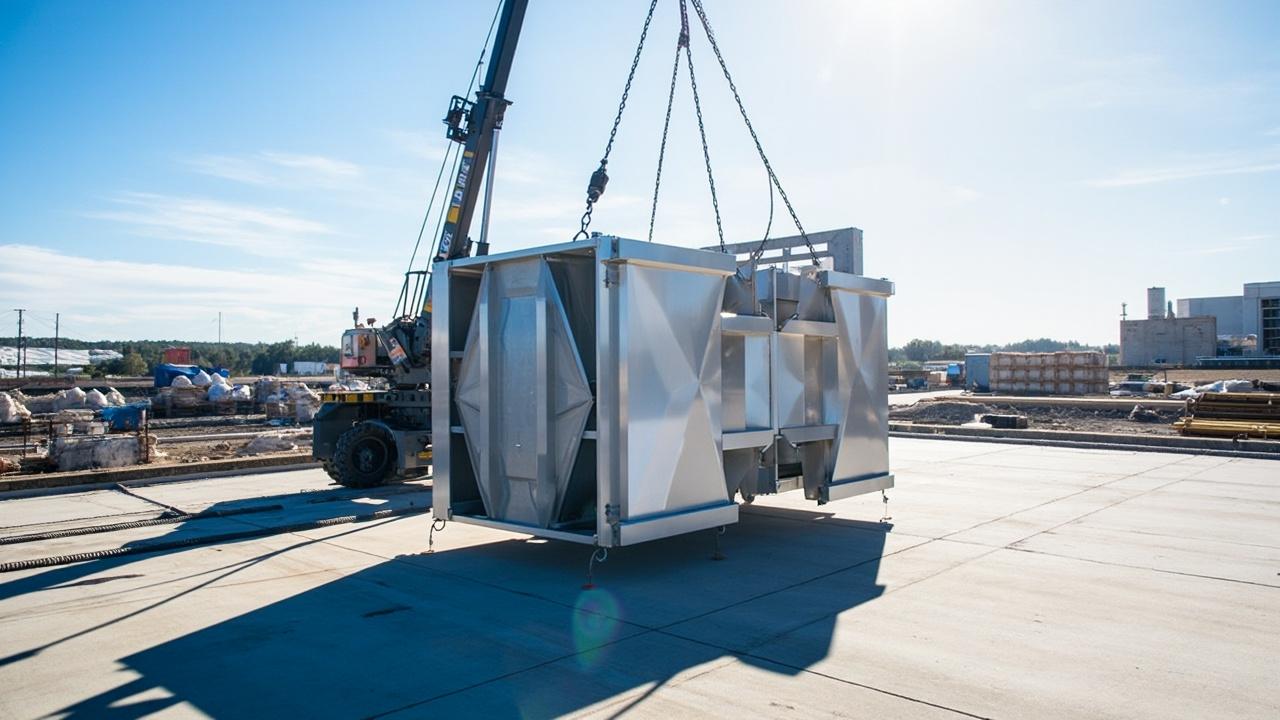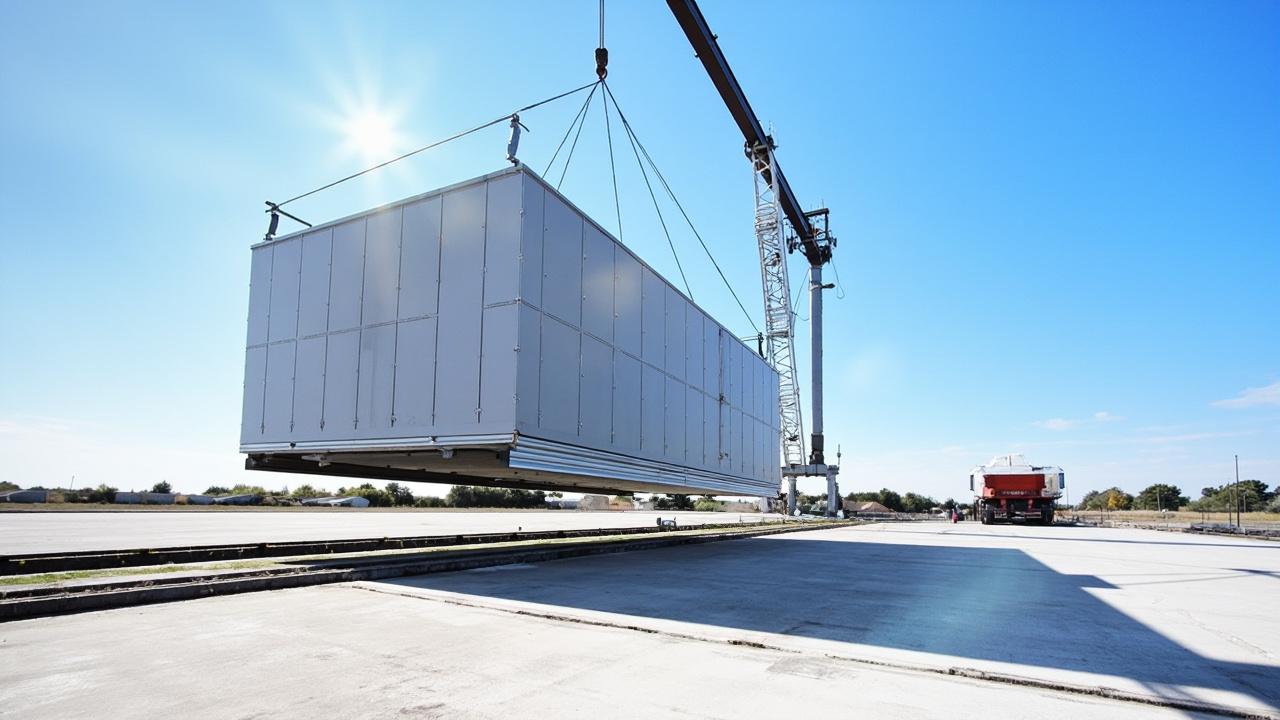Introduction
Prefabricated data centers are rapidly changing the data center landscape. By 2025, the world is projected to generate a staggering 463 exabytes of data every single day. This unprecedented growth necessitates a corresponding surge in data center capacity, placing immense pressure on organizations to expand their infrastructure quickly and efficiently.
However, traditional data center construction methods often present significant hurdles. Lengthy timelines, frequent budget overruns, and the sheer complexity of coordinating various trades and logistics can delay deployment and inflate costs.
The conventional “stick-built” approach to data center construction typically involves a drawn-out process spanning 12 to 18 months, or even longer. This extended timeline not only delays the availability of much-needed capacity but also ties up valuable capital and resources. Furthermore, the on-site construction process is prone to disruptions due to weather, material delays, and unforeseen complications, making it challenging to stay on schedule and within budget.
In contrast, prefabricated data centers offer a compelling alternative. These innovative solutions represent a paradigm shift in data center deployment, enabling organizations to achieve rapid scalability, significant cost savings, and improved efficiency. By leveraging the benefits of off-site manufacturing and modular design, prefabricated data centers are transforming the way organizations build and expand their critical infrastructure.
The Prefabricated Data Center Difference
The foundation of the prefabricated approach lies in shifting the construction environment from unpredictable job sites to controlled factory settings. Instead of battling weather delays, material shortages, and the complexities of coordinating multiple on-site trades, prefabricated data centers are meticulously crafted within the controlled confines of a manufacturing facility.
This allows for precision engineering, streamlined processes, and rigorous quality control that is difficult, if not impossible, to replicate in traditional construction. Each component, from the structural elements to the sophisticated cooling and power systems, is built to exacting specifications, ensuring seamless integration and optimal performance.
Consider the traditional “stick-built” approach, which involves constructing a data center from the ground up, piece by piece, on the final site. This method is inherently prone to delays and inefficiencies. Weather conditions can halt progress, supply chain disruptions can impact material availability, and coordinating various contractors requires significant time and resources. In contrast, prefabricated data centers offer a streamlined alternative.
Components are manufactured concurrently in the factory while site preparation occurs simultaneously, dramatically shortening the overall project timeline. This parallel construction approach is a key differentiator, allowing organizations to bring new capacity online far more quickly than with traditional methods. The modular construction of these data centers allows them to be placed in areas previously unsuitable for the traditional construction methods.
A significant benefit of prefabricated data centers is the ability to optimize design for efficiency and performance. Factory construction allows for greater standardization of components and layouts, resulting in streamlined processes and higher quality output. Unlike conventional construction, where design changes and improvisations are common, prefabricated models enable precise engineering and meticulous attention to detail.
This level of control facilitates the integration of advanced technologies, such as sophisticated cooling systems and power distribution networks, ensuring optimal energy efficiency and reliable operation. The standardization that comes with prefabricated data centers also enables easier maintenance and scalability, leading to long-term cost savings and operational efficiency.
| Feature | Traditional Construction | Prefabricated Data Centers |
|---|---|---|
| Construction Environment | Uncontrolled job site | Controlled factory |
| Timeline | 12-18+ months | 3-6 months |
| Design | Custom, prone to changes | Standardized, optimized |
Time Is Money
In today’s fast-paced digital world, the ability to rapidly deploy data center capacity can be a critical competitive advantage. Traditional data center construction projects often involve lengthy timelines, frequently stretching to 12-18 months or even longer. This extended deployment period can significantly delay revenue generation, postpone the launch of new services, and ultimately impact an organization’s bottom line.
The time it takes to build a traditional data center includes site selection, design approvals, construction, equipment procurement, and commissioning. Any delays in these processes can extend the timeline and add costs to the project.
Prefabricated data centers offer a significantly faster alternative. Because these solutions are largely constructed in a controlled factory environment, many of the delays associated with on-site construction are eliminated. This streamlined approach can compress deployment timelines dramatically, with some projects completed in as little as 3-6 months.
The reduced time to deployment translates directly into faster revenue generation, allowing organizations to capitalize on market opportunities sooner and accelerate their return on investment (ROI). For instance, a cloud service provider can launch new services faster, while a financial institution can quickly expand its trading infrastructure to meet increasing demand.
The economic impact of accelerated deployment can be substantial. Consider a scenario where a company anticipates generating \$1 million in monthly revenue from a new data center. A six-month reduction in deployment time translates to an additional \$6 million in potential revenue.
Beyond the direct revenue impact, faster deployment can also lead to cost savings in other areas, such as reduced project management expenses and lower financing costs. Moreover, the agility gained through rapid deployment allows organizations to respond more quickly to changing market conditions and adapt their infrastructure to meet evolving business needs. These factors make prefabricated data centers a compelling option for organizations seeking to maximize their ROI and gain a competitive edge.
| Data Center Construction Type | Average Deployment Time | Potential Revenue Delay (At $1m/Month) |
|---|---|---|
| Traditional “Stick-Built” | 12-18+ Months | $12M – $18M+ |
| Prefabricated | 3-6 Months | $3M – $6M |
Boosting Efficiency Across the Board
Prefabricated data centers aren’t just about speed; they’re also about optimizing every aspect of resource utilization, from energy consumption to physical footprint. Unlike traditional builds, the controlled factory environment allows for meticulous design and integration of energy-efficient technologies, leading to substantial operational savings and a smaller environmental impact. This holistic approach to efficiency makes them a compelling choice for organizations striving for sustainability and cost-effectiveness.

Energy Efficiency: A Core Design Principle
One of the most significant advantages of prefabricated designs is the ability to incorporate cutting-edge energy-saving features from the outset. This includes advanced cooling systems like free cooling or liquid cooling, optimized airflow management, and intelligent power distribution units (PDUs) that minimize energy waste. In a traditional build, these features might be retrofitted or compromised due to construction constraints.
However, with prefabricated data centers, they’re baked into the design from day one, ensuring peak energy performance. Moreover, the standardized nature of prefabricated solutions allows for precise measurement and monitoring of energy consumption, enabling continuous optimization and identification of areas for improvement. This granular level of control is often difficult to achieve in traditionally built data centers with their varied components and complex configurations.
Space Optimization: Maximizing Every Square Foot
Beyond energy, prefabricated designs excel at optimizing space utilization. The modular approach allows for a highly efficient layout, minimizing wasted space and maximizing the density of IT equipment. This is particularly crucial in urban environments or areas with limited real estate.
Furthermore, the streamlined construction process reduces the need for extensive on-site storage and staging areas, freeing up valuable space during the build phase. The reduced footprint also translates to lower construction costs and potentially lower property taxes. By precisely engineering the internal layout, prefabricated designs enable organizations to pack more computing power into a smaller space, delivering significant cost savings and improved operational efficiency.
Sustainability and Resource Management
Sustainability is no longer a buzzword; it’s a business imperative. Prefabricated methods contribute to sustainable practices through reduced waste, efficient material use, and the potential for green building certifications like LEED. The controlled factory environment minimizes construction waste, and materials can be carefully selected for their environmental impact and recyclability.
The precise engineering of these solutions reduces the likelihood of errors or rework that contributes to waste in traditional building scenarios. Furthermore, the energy efficiency gains achieved through prefabricated designs directly contribute to a lower carbon footprint, aligning with corporate sustainability goals and regulatory requirements. The ability to achieve green building certifications can also enhance a company’s reputation and attract environmentally conscious customers and investors.
Addressing Common Concerns About Prefabrication
The concept of prefabricated data centers is relatively new, so it’s understandable that data center managers and IT professionals might have some reservations. One common misconception is that prefabrication limits customization. The truth is that modern prefabricated data centers offer a high degree of flexibility.
While standardization is a core principle, the internal components and configurations can be tailored to meet specific IT requirements, power densities, and cooling needs. Manufacturers work closely with clients during the design phase to ensure the final product aligns perfectly with their operational demands. This includes choices in server racks, power distribution units (PDUs), cooling systems, and security features.
Another concern revolves around security. Are prefabricated data centers as secure as traditional builds? Absolutely. In fact, the controlled factory environment often allows for more rigorous security measures during construction.
can be integrated directly into the module during the manufacturing process, ensuring a robust security posture from day one. Furthermore, reputable vendors adhere to industry security standards and can assist with compliance requirements such as PCI DSS, HIPAA, and SOC 2.
Finally, some worry about scalability and the ability to adapt to future growth. The modular nature of prefabricated data centers is actually a significant advantage in this regard. Additional modules can be easily added as needed, providing a seamless and cost-effective way to scale capacity without the disruption and expense of traditional expansion projects. This scalability extends beyond just adding more space; it also includes the ability to upgrade components, integrate new technologies, and adapt to evolving business needs.
Prefabricated Data Centers
Organizations across various sectors are increasingly turning to prefabricated data centers to meet their growing infrastructure demands, and the proof is in the deployments. One prime example is a large financial institution that needed to rapidly expand its data center capacity to support its growing online banking operations. Traditional construction methods would have taken well over a year, disrupting services and impacting revenue.
Instead, they opted for a prefabricated solution and were able to bring a fully operational data center online in just four months. This accelerated deployment enabled them to launch new services ahead of schedule and gain a competitive edge in the market.
Another success story comes from a leading e-commerce company that needed to deploy a new data center at the edge to improve its content delivery network (CDN). They wanted to reduce latency and improve the user experience for customers in a specific geographic region.
Due to time constraints and limited available space at the edge location, traditional construction was not feasible. They selected a prefabricated solution which they were able to customize to fit the spatial requirements of their location and were up and running in just three months.
These real-world examples demonstrate the tangible benefits of prefabricated data centers. The common thread in these success stories is the ability to overcome the limitations of traditional construction, accelerate deployment, reduce costs, and improve overall efficiency. By choosing prefabricated solutions, organizations can gain a significant competitive advantage and achieve their business goals faster.
Choosing the Right Prefabricated Data Center Solution
When embarking on a prefabricated data center project, the selection of the right vendor and solution is paramount to achieving the desired outcomes. It’s not simply about choosing the lowest price; it’s about finding a partner that understands your unique business requirements and can deliver a solution that aligns with your long-term strategic goals. A poorly chosen vendor can lead to delays, cost overruns, and a final product that doesn’t meet your needs.
Evaluating Design and Engineering Expertise
One of the most critical factors to consider is the vendor’s design and engineering capabilities. A reputable provider will have a team of experienced engineers who can work with you to design a data center that is optimized for your specific application. This includes factors such as power density, cooling requirements, and space constraints.
Ensure that the vendor has a proven track record of designing and delivering high-performance data centers. Ask for detailed design documentation and simulations to verify that the proposed solution will meet your performance expectations.

Manufacturing Quality and Project Management
The quality of the manufacturing process is another key consideration. The vendor should have a state-of-the-art manufacturing facility and a robust quality control program. Look for certifications such as ISO 9001 to ensure that the vendor adheres to industry best practices. Equally important is the vendor’s project management capabilities.
A successful prefabricated data center deployment requires careful planning and coordination. The vendor should have a dedicated project management team that can oversee all aspects of the project, from design and manufacturing to transportation and installation. Because prefabricated data centers depend on their pieces fitting together with great accuracy, you should make sure the project management is well planned and executed.
Prioritizing Experience and a Proven Track Record
Finally, it’s essential to choose a partner with a proven track record and expertise in data center infrastructure. Ask for references from previous customers and take the time to visit some of their completed projects. This will give you a firsthand look at the quality of their work and the level of customer satisfaction.
Don’t be afraid to ask tough questions and demand clear and concise answers. The right vendor will be transparent and willing to share their expertise with you. By carefully evaluating these key considerations, you can increase your chances of a successful prefabricated data center deployment and achieve the benefits of speed, efficiency, and cost savings.
The Future Is Modular
The escalating demands of edge computing, artificial intelligence (AI), and the Internet of Things (IoT) are reshaping the data center landscape. These technologies require data processing closer to the source, leading to a surge in demand for distributed and rapidly deployable infrastructure. Traditional brick-and-mortar data centers simply cannot keep pace with the speed and flexibility required to support these emerging trends.
This is where the inherent advantages of modularity and standardization in prefabricated data centers come to the forefront. These are not just a temporary solution; they represent a fundamental shift in how data center infrastructure is conceived, built, and deployed.
The inherent scalability and adaptability of modular designs perfectly align with the dynamic needs of modern businesses. Imagine needing to quickly expand capacity to support a new AI initiative or deploy infrastructure at the edge to improve IoT sensor response times. With *prefabricated data centers*, you can simply add or reconfigure modules as needed, avoiding the lengthy construction timelines and complex logistics associated with traditional methods.
Here’s why prefabricated data centers are poised to dominate the future:
The shift towards modularity isn’t just a trend; it’s a necessity for organizations seeking to stay competitive in today’s rapidly evolving digital landscape. By embracing the flexibility and efficiency of prefabricated data centers, businesses can unlock new possibilities and drive innovation across their operations.
Optimizing Operations With Standardized Data Centers
The move towards standardization in data center design and operations is no longer a luxury, but a necessity for organizations striving for peak performance and agility. By embracing prefabricated data centers, companies can achieve a level of operational optimization that’s simply unattainable with traditional, bespoke builds.
The inherent modularity and standardized components of these solutions allow for streamlined maintenance, easier troubleshooting, and faster replacements. Imagine the reduced downtime and increased productivity when technicians can quickly identify and swap out a faulty module, instead of spending days diagnosing a complex, custom-built system.
Furthermore, the standardization facilitated by prefabricated data centers enables centralized monitoring and management. With consistent hardware and software platforms across deployments, IT teams can gain a holistic view of their entire infrastructure, regardless of location. This enhanced visibility empowers proactive maintenance, predictive analytics, and ultimately, a more resilient and efficient data center operation. This also enhances cybersecurity posture because the vulnerabilities are well known and can be mitigated rapidly across the entire enterprise.
In conclusion, the operational benefits of standardized data centers, particularly those achieved through the adoption of prefabricated data centers, are undeniable. From simplified maintenance and faster repairs to centralized monitoring and improved security, the advantages are compelling. For organizations seeking to optimize their data center operations and unlock new levels of efficiency, exploring the possibilities of prefabricated solutions is a strategic imperative.
Frequently Asked Questions
What are the key benefits of using prefabricated data centers compared to traditional construction?
Prefabricated data centers offer several advantages over traditional construction methods. One significant benefit is the accelerated deployment timeline. Since much of the construction occurs offsite in a controlled environment, site preparation and module installation are often completed faster.
Reduced costs are another key advantage, stemming from streamlined construction processes, bulk material purchasing, and minimized on-site labor expenses. Improved quality control also results from the factory setting, ensuring consistent and reliable construction.
How customizable are prefabricated data centers to meet specific business requirements?
Prefabricated data centers are highly customizable to accommodate diverse business needs. Manufacturers offer a range of options regarding size, power density, cooling solutions, and security features.
Clients can tailor the design to meet specific requirements for IT infrastructure, environmental controls, and redundancy levels. This flexibility ensures that the prefabricated data center aligns perfectly with the operational and technological demands of the organization.
What is the typical lead time for deploying a prefabricated data center?
The typical lead time for deploying a prefabricated data center is significantly shorter compared to traditional builds. While traditional construction projects can take many months or even years, prefabricated solutions often require only weeks or a few months from order placement to full operation.
This accelerated timeline allows businesses to quickly expand their data center capacity or establish new facilities without prolonged delays.
What are the different types of prefabricated data center modules available?
Prefabricated data center modules come in several different types, each designed to meet specific needs. Containerized modules are self-contained units that can be easily transported and deployed. Skid-mounted modules are typically built on a steel frame and house essential infrastructure components.
Building-within-a-building modules are designed to be integrated into existing facilities. These various types enable flexibility in choosing the best option.
What infrastructure components are typically included in a prefabricated data center?
A prefabricated data center typically includes a comprehensive suite of infrastructure components essential for reliable operation. This often encompasses power distribution units (PDUs), uninterruptible power supplies (UPS), cooling systems such as CRAC or in-row cooling, fire suppression systems, and environmental monitoring systems. These pre-integrated components contribute to the data center’s efficiency and resilience.




